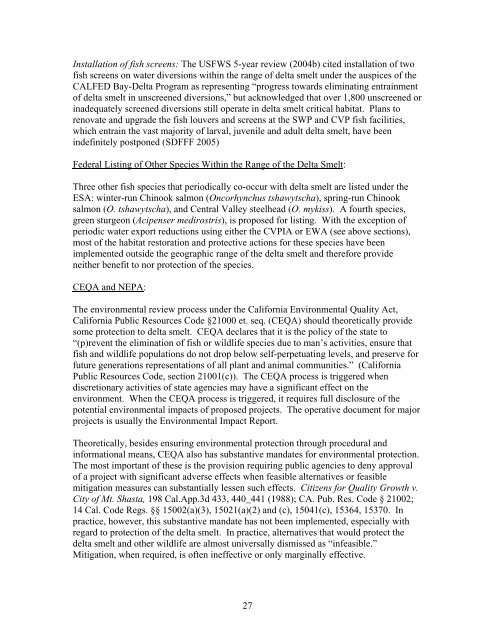ESWR page - Endangered Species & Wetlands Report
ESWR page - Endangered Species & Wetlands Report
ESWR page - Endangered Species & Wetlands Report
Create successful ePaper yourself
Turn your PDF publications into a flip-book with our unique Google optimized e-Paper software.
Installation of fish screens: The USFWS 5-year review (2004b) cited installation of two<br />
fish screens on water diversions within the range of delta smelt under the auspices of the<br />
CALFED Bay-Delta Program as representing “progress towards eliminating entrainment<br />
of delta smelt in unscreened diversions,” but acknowledged that over 1,800 unscreened or<br />
inadequately screened diversions still operate in delta smelt critical habitat. Plans to<br />
renovate and upgrade the fish louvers and screens at the SWP and CVP fish facilities,<br />
which entrain the vast majority of larval, juvenile and adult delta smelt, have been<br />
indefinitely postponed (SDFFF 2005)<br />
Federal Listing of Other <strong>Species</strong> Within the Range of the Delta Smelt:<br />
Three other fish species that periodically co-occur with delta smelt are listed under the<br />
ESA: winter-run Chinook salmon (Oncorhynchus tshawytscha), spring-run Chinook<br />
salmon (O. tshawytscha), and Central Valley steelhead (O. mykiss). A fourth species,<br />
green sturgeon (Acipenser medirostris), is proposed for listing. With the exception of<br />
periodic water export reductions using either the CVPIA or EWA (see above sections),<br />
most of the habitat restoration and protective actions for these species have been<br />
implemented outside the geographic range of the delta smelt and therefore provide<br />
neither benefit to nor protection of the species.<br />
CEQA and NEPA:<br />
The environmental review process under the California Environmental Quality Act,<br />
California Public Resources Code §21000 et. seq. (CEQA) should theoretically provide<br />
some protection to delta smelt. CEQA declares that it is the policy of the state to<br />
“(p)revent the elimination of fish or wildlife species due to man’s activities, ensure that<br />
fish and wildlife populations do not drop below self-perpetuating levels, and preserve for<br />
future generations representations of all plant and animal communities.” (California<br />
Public Resources Code, section 21001(c)). The CEQA process is triggered when<br />
discretionary activities of state agencies may have a significant effect on the<br />
environment. When the CEQA process is triggered, it requires full disclosure of the<br />
potential environmental impacts of proposed projects. The operative document for major<br />
projects is usually the Environmental Impact <strong>Report</strong>.<br />
Theoretically, besides ensuring environmental protection through procedural and<br />
informational means, CEQA also has substantive mandates for environmental protection.<br />
The most important of these is the provision requiring public agencies to deny approval<br />
of a project with significant adverse effects when feasible alternatives or feasible<br />
mitigation measures can substantially lessen such effects. Citizens for Quality Growth v.<br />
City of Mt. Shasta, 198 Cal.App.3d 433, 440_441 (1988); CA. Pub. Res. Code § 21002;<br />
14 Cal. Code Regs. §§ 15002(a)(3), 15021(a)(2) and (c), 15041(c), 15364, 15370. In<br />
practice, however, this substantive mandate has not been implemented, especially with<br />
regard to protection of the delta smelt. In practice, alternatives that would protect the<br />
delta smelt and other wildlife are almost universally dismissed as “infeasible.”<br />
Mitigation, when required, is often ineffective or only marginally effective.<br />
27
















